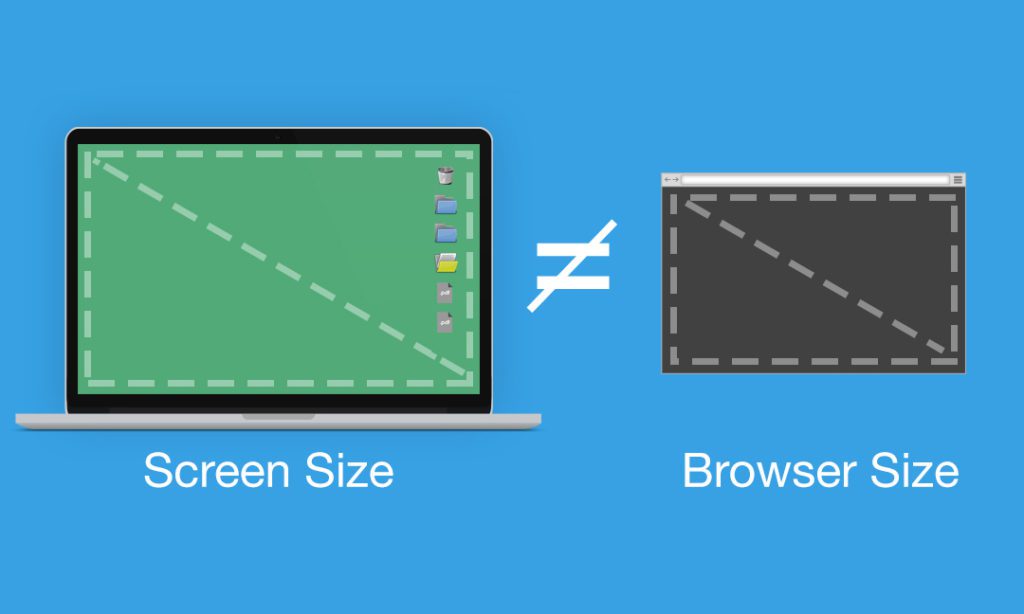Screen Resolution has been available in GA and gets widely used for User Experience analysis. For example, we can use it to judge just where the fold is for different users.
Assuming their browser is maximized to their screen, that works fairly well.
But you know what they say about assumptions.
Well, assume no more, my friends – the new GA dimension Browser Size is here.
New GA Browser Size tells you just how large the user’s browser viewport actually is.
This has some obvious UX/UI analysis implications. It can be used in the same types of analysis you were using Screen Resolution for, but it’s more accurate. You can use it for above the fold analysis, for page scroll analysis. You might even compare Screen Resolution to View Port size!
Less obvious (but more interesting) are the possible uses for fraud detection.
Fraud is everywhere. Not only is the internet no different, it has become the poster child for fraud!
Affiliate Fraud Detection
Affiliate fraud, for instance, where shady websites will secretly load an iframe with content from site such as Amazon using their Affiliate Link. Load that from enough browsers, and at least some of them are going to purchase from Amazon in the next 24 hours, giving credit to previously mentioned shady website and Amazon says “Thank You” by sending them 3-4% of the revenue from your purchase!
Or how about the shady SEO agency that promises more traffic to your site, and then provides it by getting people to visit a single page that contains unseen iframes of all their client sites that they’re getting paid to send traffic to. Traffic goes up, just like they promised, and the proof is in the GA data — can’t argue with that right?
What do these scenarios and others have in common? Browser viewport size for a visit like this is often 0 x 0, 1 x 1 or something similar from the screenshot below.
[Note: Actual Browser Size is rounded to the nearest multiple of 10. So 0 x 0 includes those 1 x 1’s]
If you find a referral source that has a large percentage of these suspect viewport sizes, it may be a candidate for further investigation.
In the screenshot above, does this mean that barclays.com is a fraud suspect? Probably not, with only 5 sessions, but let’s take a closer look.
What we see here is a healthy distribution of Browser Size values, and that’s what we’re looking for.
Barclays is safe from our wrath. . .for now.
What I would really like to show you is a way to create intelligence alerts based on Browser Size dimension, but it isn’t currently supported.
But Don’t Panic — we’ve already provided this as feedback to Google!
Until then, what we can do is group all of the suspect values of Browser Size into a single value called “Suspected Fraud” or “Very Small” with a View filter.
For right now we’ll go with matching anything that starts with 0x or ends in x0.
The benefit of doing this is that you now have all of the suspect values grouped together for analysis purposes. You’ll be able to see the total sessions with “tiny” Browser Size for each referrer or other dimension rather than having them spread out among many individual values.
You could also use a Custom Segment to take a look:
[Note: If you use the above filter to aggregate these values, then your Custom Segment would need to match “Possible Fraud”]
Now you can do a report by referrer (or other dimension) with the Suspected Fraud segment and the All Sessions segment for context:
What you’re looking for in this report is
- Suspected Fraud sessions in a row are a significant percent of All Sessions
- All Sessions for a referrer is a significant portal of sessions for the site.
Do we find that in this report?
In this case, we do have one referrer above that meets condition #1, but it doesn’t meet condition #2.
Since it is only 3 sessions out of 1.8 million, we’re going to decide to spend our valuable time elsewhere.
So there you have it. We have one more tool in our arsenal.
Now get back to work!

























